The Writer’s Thoughts
Louisa May Alcott — On Motherhood
In this great world of ours, there is no more vital or noble work than that of motherhood. It is the foundation upon which all else is built, and the force that shapes not only our homes, but also our society and our future. A mother is the first teacher, the first nurse, and the first friend of her children, and her influence is felt in every sphere of life. Her love, her care, and her wisdom are the precious gifts that no other can bestow so freely and so well.
There is no limit to the power of a mother's love, for it is a force that can move mountains, heal wounds, and bind up the broken-hearted. It is a love that knows no bounds, and that endures through all the trials and tribulations of life. The bond between a mother and her child is strong and enduring, and it is this bond that gives the child a sense of security and the confidence to face the challenges of life.
Mothers are the guardians of the home, the keepers of the family traditions, and the transmitters of cultural values. They are the first to instill in their children the principles of right and wrong, and to teach them the importance of respect, kindness, and compassion. It is in the mother's lap that the child first learns the meaning of love, and it is from her example that the child learns the value of empathy and understanding.
In addition to her roles as teacher and moral guide, a mother also serves as a model of strength, resilience, and perseverance. She is a pillar of support for her children, and her presence is a constant source of comfort and reassurance. It is the mother who bears the burdens of her family with grace, who faces adversity with courage, and who always puts the needs of her children before her own. Her selflessness and her devotion to her family are qualities that inspire admiration and respect, and that serve as an example for all to follow.
But perhaps the most significant aspect of motherhood is its ability to transform the lives of those who embrace it. In becoming a mother, a woman discovers within herself a wellspring of love and tenderness, and she learns to nurture and care for another human being in a way that is both selfless and profound. This transformative power of motherhood extends beyond the family and into society as a whole, for it is through the love and guidance of mothers that we raise the next generation of leaders, thinkers, and artists. As such, we must recognize and celebrate the importance of mothers and the work they do, for it is through their efforts that we shape the world of tomorrow.
Food For Thought
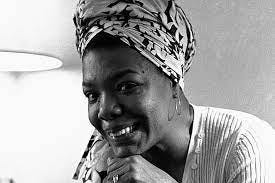
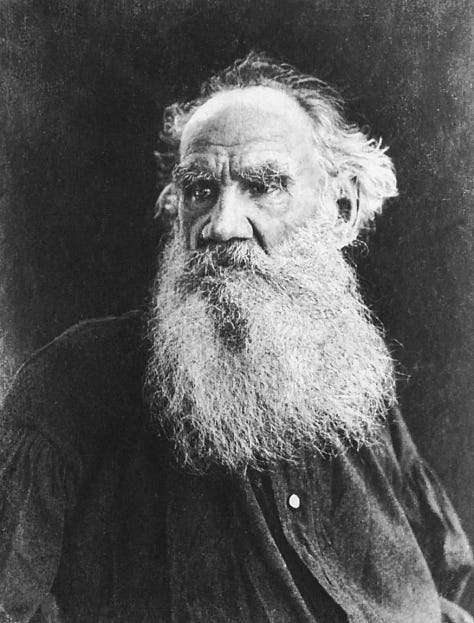
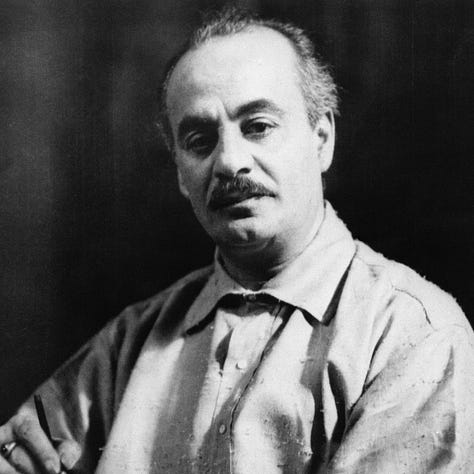
Leo Tolstoy |"Only a mother's love can make a house a home, for it is her presence that fills it with warmth and life. Her care, her patience, and her understanding are the foundation upon which all else rests."
Leo Tolstoy, born in 1828, was a Russian writer and philosopher whose notable works include "War and Peace" and "Anna Karenina." Born into a noble family, Tolstoy lost his parents early in life and was raised by relatives. He went on to study law and languages at Kazan University, but left without completing his degree.
Tolstoy's career took off after joining the army in the 1850s, during which he wrote the semi-autobiographical "Sevastopol Sketches," capturing the realities of war. Later, his literary achievements peaked with "War and Peace" (1869) and "Anna Karenina" (1877), both exploring themes of society, morality, and the human experience.
Tolstoy's personal life was tumultuous; he married Sofya Andreyevna in 1862 and fathered 13 children. Their relationship was strained by Tolstoy's spiritual transformation in the 1870s, when he renounced his aristocratic lifestyle and embraced Christian anarchism, pacifism, and an ascetic existence.
Influenced by this transformation, Tolstoy wrote "The Kingdom of God Is Within You" (1894), where he critiqued the church and state, championing nonviolent resistance. This work directly inspired Mahatma Gandhi, who later corresponded with Tolstoy.
In 1910, Tolstoy left his family estate, seeking a simpler life. He fell ill during his journey and passed away at Astapovo train station, aged 82. Tolstoy's literary and philosophical legacy continues to inspire and provoke thought today.
Khalil Gibran | "The most beautiful word on the lips of mankind is the word 'Mother,' and the most beautiful call is the call of 'My mother.' It is a word full of hope and love, a sweet and kind word coming from the depths of the heart."
Kahlil Gibran (1883-1931) was a Lebanese-American poet, writer, and artist whose work gained international acclaim. Born in Bsharri, Lebanon, Gibran immigrated to the United States in 1895, settling in Boston with his family. His early exposure to the diverse cultural milieu of the city greatly influenced his artistic development. He was primarily self-taught, but also studied at the Académie Julian in Paris.
Gibran's work blended Eastern and Western spiritual traditions, exploring themes of love, spirituality, and the human condition. He wrote both in Arabic and English, often addressing social issues and advocating for Lebanese nationalism. His most famous work, "The Prophet" (1923), became a bestseller and a cornerstone of 20th-century literature. It is a collection of 26 poetic essays in which the titular character, Almustafa, shares his wisdom on various aspects of life.
Beyond writing, Gibran was a skilled visual artist, producing numerous paintings and drawings that often accompanied his literary works. His art was exhibited in major cities like New York, Boston, and Paris.
Despite his professional success, Gibran faced personal challenges, including a tumultuous love life and struggles with alcoholism. He passed away at the age of 48 in New York City. Today, Gibran's work continues to inspire readers and holds a special place in the canon of global literature.
Maya Angelou | "To describe my mother would be to write about a hurricane in its perfect power. Or the climbing, falling colors of a rainbow."
Maya Angelou, born Marguerite Annie Johnson on April 4, 1928, in St. Louis, Missouri, was a prolific American author, poet, and civil rights activist. She overcame a traumatic childhood, marked by racial discrimination and sexual abuse, to become a powerful literary voice. Angelou's work often focused on themes of resilience, identity, and the African American experience.
Her career took off with the publication of her groundbreaking autobiography, "I Know Why the Caged Bird Sings" (1969), which chronicled her early life and became a best-seller. The book was also the first in a seven-volume series, showcasing her incredible storytelling ability. Angelou went on to publish numerous collections of poetry and essays.
In addition to her literary career, Angelou was an accomplished actor, dancer, and singer. She worked with notable figures like Martin Luther King Jr., Malcolm X, and James Baldwin, actively participating in the civil rights movement. In 1993, she recited her poem "On the Pulse of Morning" at President Bill Clinton's inauguration, becoming the first poet to do so since Robert Frost in 1961.
Maya Angelou received numerous awards and honors, including the Presidential Medal of Freedom in 2011. She passed away on May 28, 2014, leaving behind a lasting legacy that continues to inspire generations of readers and writers.
The Gallery
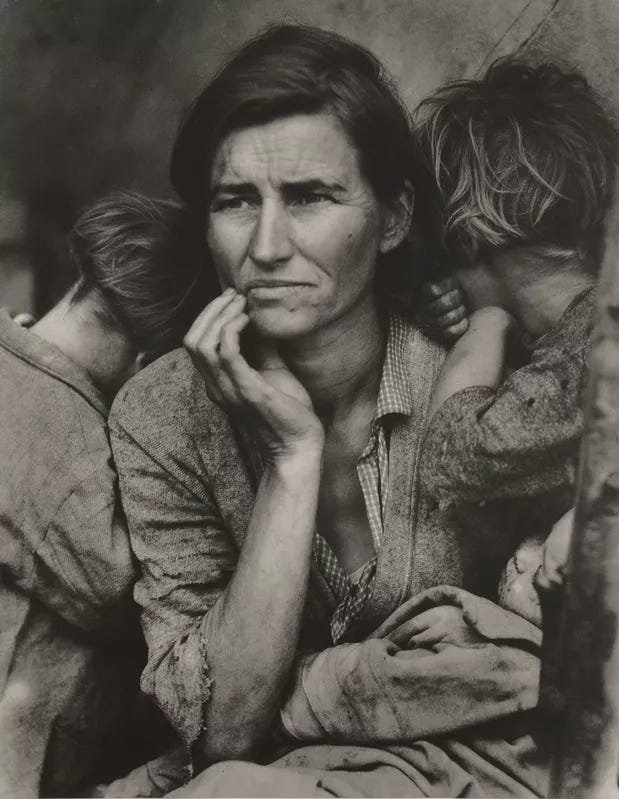
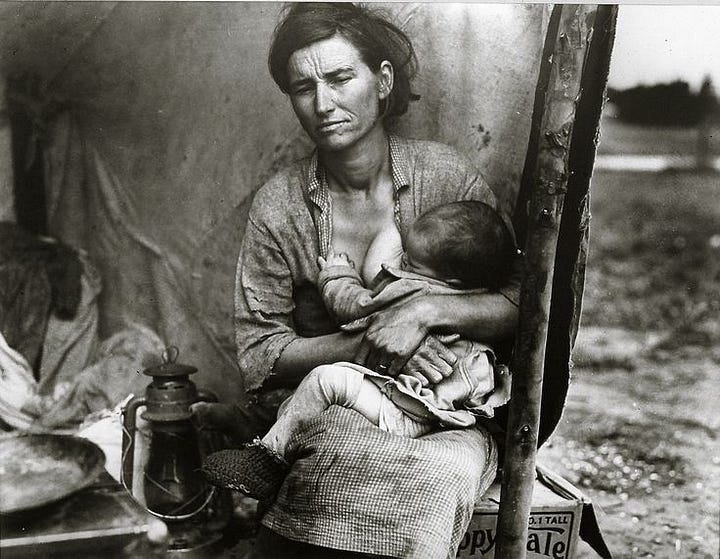
"Migrant Mother" by Dorothea Lange (1936)
The photo "Migrant Mother" is an iconic black-and-white photograph taken by Dorothea Lange during the Great Depression in the United States. The image was captured in 1936 at a pea-pickers' camp in Nipomo, California. It features a 32-year-old woman named Florence Owens Thompson, along with three of her children.
In the photograph, Florence is the central figure, looking off into the distance with a furrowed brow and an expression that conveys worry, exhaustion, and determination. She is holding an infant in her lap, while two other children, their faces turned away from the camera, cling to her from either side. The image captures a sense of despair, resilience, and vulnerability, providing a powerful and poignant representation of the struggles faced by countless families during the Great Depression.
"Migrant Mother" is considered significant for a number of reasons. Firstly, it is an outstanding example of documentary photography, demonstrating Lange's ability to convey a powerful narrative through a single image. The photograph has become emblematic of the Great Depression, providing an enduring reminder of the hardships faced by millions during that time.
Secondly, the image played a crucial role in raising awareness and garnering public support for government programs aimed at helping those affected by the Depression. After its publication, the photograph helped to humanize the plight of migrant workers and put a face on the suffering that was so widespread across the country. This, in turn, played a part in fostering support for New Deal policies and other relief efforts.








